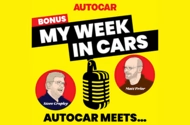Renault’s Vision: Insights from CEO Fabrice Cambolive
In a recent episode of the ‘Autocar Meets’ podcast, associate editor James Attwood had the opportunity to sit down with Fabrice Cambolive, the CEO of Renault. Their conversation delved into the intricate world of automotive leadership, touching on everything from the challenges of steering a historic brand to the exciting future of electrification. If you’ve ever wondered what it’s like to lead a major car manufacturer in today’s rapidly changing landscape, this discussion offers a wealth of insights.
What Are the Biggest Challenges Facing Renault?
Running a legacy brand like Renault comes with its unique set of challenges. Cambolive highlighted that beyond the typical concerns like tariffs and market competition, there’s a pressing need to adapt to consumer preferences that are shifting towards sustainability. The automotive industry is in a state of flux, and for a brand with deep historical roots, balancing tradition with innovation is no small feat. Cambolive’s approach? Embrace change while respecting the brand’s heritage.
He emphasized that understanding customer expectations is crucial. Today’s consumers are not just looking for a car; they want a vehicle that aligns with their values, particularly regarding environmental impact. This shift is prompting Renault to rethink its offerings and invest heavily in electrification.
Why Retro Design Matters
One of the more intriguing topics Cambolive discussed was the appeal of retro design. In a world where technology often takes center stage, there’s a nostalgic charm in designs that harken back to simpler times. Cambolive believes that incorporating retro elements can create a deeper emotional connection with consumers. It’s not just about aesthetics; it’s about storytelling. Cars that evoke memories or feelings can resonate more strongly with buyers, making them feel part of a larger narrative.
This approach is particularly relevant as Renault looks to revitalize its lineup. By blending modern technology with classic design cues, the brand aims to attract both new customers and loyal fans who appreciate the history behind the vehicles. It’s a clever strategy that acknowledges the past while paving the way for the future.
The Push for Electrification
Electrification is at the forefront of the automotive industry, and Renault is no exception. Cambolive shared insights into how the company is navigating this transition. With increasing regulations and a global push towards greener alternatives, Renault is committed to expanding its electric vehicle (EV) offerings. The goal is not just to keep up with competitors but to lead in the EV space, making electric mobility accessible and appealing to a broader audience.
Cambolive pointed out that the transition to electric vehicles is not merely about swapping out engines; it’s about rethinking the entire ecosystem—from manufacturing processes to charging infrastructure. This holistic approach is essential for ensuring that Renault’s EVs are not only innovative but also practical for everyday use.
What’s Next for Renault?
As the conversation wrapped up, it became clear that Cambolive is optimistic about Renault’s future. The brand’s commitment to sustainability, coupled with a focus on design and customer experience, positions it well in an increasingly competitive market.
For those interested in the automotive industry, Cambolive’s insights serve as a reminder that the road ahead is filled with both challenges and opportunities. The key takeaway? It’s not just about building cars; it’s about creating a brand that resonates with people on multiple levels.
If you’re curious to dive deeper into this conversation, you can listen to the full podcast episode. It’s a fascinating exploration of what it takes to lead a major automotive brand in today’s complex landscape.
The big takeaway? Leading a legacy brand like Renault isn’t just about navigating challenges; it’s about embracing change and crafting a narrative that connects with consumers. Start by reflecting on what your own brand story is, and you might just find new ways to engage your audience.

